Section 9 of The Subdivision Regulations, 2014 outlines the fees associated with the examination of subdivision applications. These fees represent a portion of the cost to the ministry to review and render a decision for subdivision applications. The fees are as follows:
- $300 for each new parcel created by the subdivision
- This amount is non-refundable.
- Parcels for public highway, dedicated lands or public works are exempt from this fee.
- If more parcels are added to the plan of proposed subdivision during the review of a subdivision application, an additional per parcel fee is required.
- Refunds will not be provided for a reduction in parcels.
- $150 per application for a Notice of Decision
- In the event an application is withdrawn before a decision is made, this amount will be refunded.
- $100 for the re-issuance of a Notice of Decision, if necessary
- Pursuant to section 129 of the Act, a Notice of Decision is valid for 24 months and may be extended once for an additional 24 months if the request is received before the expiry date.
- If the deadline has passed, the request will be deemed a new application that is subject to the full fees.
The fees are exempt from GST and PST and can be paid online through the Land Planning and Development Application for online subdivision applications or by check or money order made payable to the Saskatchewan Minister of Finance for paper submissions.
Additional fees may be applicable for registering any interests (i.e. caveats) respecting a subdivision application. A caveat is a legal instrument applied to land through Information Services Corporation (see Interest Registration Services > Registration of all Other Interests). A caveat informs people looking at the title of additional interests held in the land by parties other than the landowner. The Act allows subdivision approving authorities and municipal councils to register caveats. During the review of a subdivision application, the Ministry of Government Relations will advise applicants if there are additional fees associated with their application.
Sample Urban Scenarios
Disclaimer: The bold dashed line in these scenarios is shown for illustrative purposes only. Final determination of application fees is subject to review.
In an urban context, the bold dashed line must outline all the parcels being created or modified as a result of subdivision, and all parcels are subject to the $300 per parcel fee.
Each of the following four examples are subject to a fee of $750, based on $600 for two parcels plus $150 for issuing a Notice of Decision.


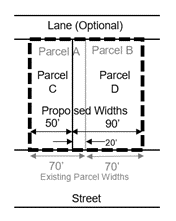

The example below is subject to a fee of $2,850, based on $2,700 for nine new parcels plus $150 for issuing a Notice of Decision.

Sample Rural Scenarios
Disclaimer: The bold dashed line in these scenarios is shown for illustrative purposes only. Final determination of application fees is subject to review.
The following examples are subject to a fee of $450, based on $300 for one new parcel plus $150 for issuing the Notice of Decision.

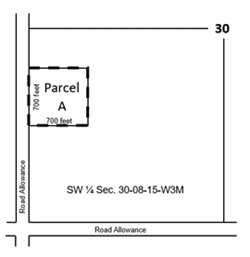


The example below is subject to a fee of $750, based on $600 for two new parcels plus $150 for issuing a Notice of Decision.
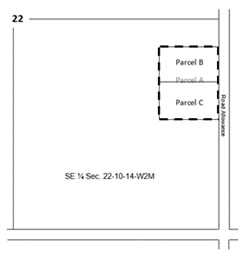
The example below is subject to a fee of $2,550, based on $2,400 for eight new parcels plus $150 for issuing a Notice of Decision.
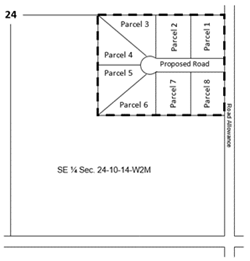
The following subdivision is subject to a fee of $450, based on $300 for new Parcel B, $150 for issuing a Notice of Decision.
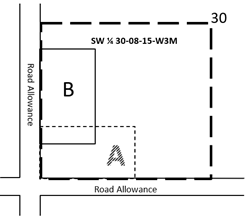
Parcel Tie Scenarios
Disclaimer: The bold dashed line in these scenarios is shown for illustrative purposes only. Final determination of application fees is subject to the Ministry of Government Relations' review.
The example below is subject to a fee of $450, based on $300 for the subdivision of a single parcel tie removal, plus $150 for issuing a Notice of Decision.


The example below is subject to a fee of $750, based on $600 for the parcel tie re-arrangement that results in two new parcels plus $150 for issuing a Notice of Decision.
















